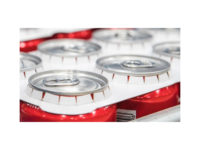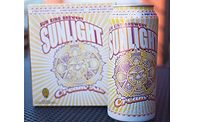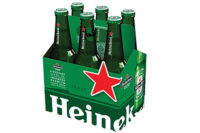What consumers want from secondary packaging
Paperboard, shrink films, ring carriers complement primary packaging

Zumbiel Packaging’s Z-View paperboard secondary packaging allows consumers to see and touch the beverage containers inside the carrier. (Image courtesy of Zumbiel Packaging and Dr Pepper Snapple Group)

The see-through quality of shrink-wrap secondary packaging allows the primary packaging to shine, says Dow’s Philipp Luijckx. (Image courtesy of Nestlé Waters North America)

PakTech’s Can Carriers and other ring carriers give multipacks of cans or bottles a unique look on the shelf, Amie Thomas says. (Image courtesy of PakTech)

Hi-Cone’s Impact ring carriers are equipped to carry promotional items, such as fireworks-viewing glasses, giving the secondary packaging an interactive component. (Image courtesy of Hi-Cone)

Consumers trust that paperboard carriers with handles are strong enough to support the weight of alcohol beverages in glass bottles, Zumbiel Packaging’s Tom Zumbiel notes. (Image courtesy of MillerCoors)





Batman has Robin, Andy Taylor has Barney Fife, Han Solo has Chewbacca, and Pinocchio has Jiminy Cricket. While sidekicks might be the background character in all of these famous duos, secondary packaging has more of a spotlight position in its role as primary packaging’s sidekick.
Although secondary in name, secondary packaging is often what the consumer sees first on the shelf, notes Charles Pavia, director of marketing for Proactive Packaging and Display, Ontario, Calif. For example, on six-packs of beer bottles, the secondary packaging in the form of a corrugated carrier serves as the advertising component of the package, he explains.
In fact, branding is one of the three main features consumers look for in secondary packaging, says Renata Neri, global marketing manager for beverages at Graphic Packaging International, a wholly owned subsidiary of Atlanta-based Graphic Packaging Holding Co. “Secondary packaging allows brands to extend their marketing on the shelves and offers a consistent product image across the retail environment,” she says. “It provides a billboard space not only for branding and promotion but also to communicate to consumers new flavor introductions or nutritional information that nowadays is so demanded.
“At the same time, using shapes, windows, cutouts and decoration enhancements can either complement or highlight primary containers,” she continues.
Zumbiel Packaging, Hebron, Ky., offers its Z-View corrugated carrier to enhance the primary packaging without hiding it, says Marketing and Sustainability Director Tom Zumbiel. The secondary packaging design includes cut-outs that allow the consumer to see the bottles or cans inside the carrier but still offers additional branding opportunities and keeps the multipack together, he says.
Plastic shrink-wrap packaging serves the multipack-wrapping purpose but also lets the primary packaging shine, points out Philipp Luijckx, marketing manager for Dow’s Industrial and Consumer Packaging business, an operating unit of Midland, Mich.-based The Dow Chemical Co.’s Performance Packaging division. “For example, you can have clear film, you can have [some] of it printed, and that allows consumers to see what’s in the package,” he says.
First line of defense
In addition to being the primary marketing front, consumers also expect secondary packaging to be a product’s first line of defense.
“Consumers are almost married to the brands [they buy],” Dow’s Luijckx explains. “The only thing that would make them switch … from a secondary packaging point of view … is if the secondary packaging would fail on them, and they lose product. That is when they would reconsider a brand choice.”
For example, Zumbiel Packaging’s Zumbiel says that paperboard packaging conveys a protective quality because of its strength. “Consumers are sure that the handles on paperboard [carriers] will withstand the weight of the product,” he says. “In addition, paperboard is sturdy and less susceptible to ripping and tearing.”
On the other hand, Dow’s Luijckx says his company goes the extra mile to ensure that its plastic resins used in secondary packaging can handle any rough handling consumers throw at it. “We do a five-time pull test on shrink film to simulate the number of times the package is handled from putting it on the shelf … to cart, to checkout lane, to car, to home to make sure the film will hold up to the test of the consumer,” he says.
However, few consumers come into contact with secondary packaging frequently, and most consumers view the packaging as excessive, says Don Reggio, marketing director for corrugated packaging at RockTenn, Norcross, Ga. Very few consumers understand the role that packaging plays to protect the product during shipping and other points of handling, he says. For this reason, it is important that secondary packaging’s protective features be coupled with other functional benefits.
In fact, functionality, in terms of easy carrying, storage and dispensing, is another of the Top 3 features consumers look for in secondary packaging, Graphic Packaging International’s Neri says.
For example, the Fridge Vendor or fridge pack carton style is the most popular paperboard packaging format sold in the beverage industry today, Neri says. “This carton design resulted from intensive consumer research conducted in 2002 by Graphic Packaging International in partnership with [New York-based] Alcoa,” she explains. “The collected insights inspired our design team to create and patent a paperboard packaging solution that allows consumers to have more cold product available, consequently increasing consumption. The 12-pack of 12-ounce cans fits in the consumer’s fridge and includes a distinctive opening feature for easy can dispensing.”
Paperboard packaging also can be structurally modified to include handles and other easy-open features for additional functionality, Neri adds. Dow’s Luijckx says consumers are interested in these features for their shrink-wrapped products too, because they don’t want to struggle to retrieve the product inside. This gives packagers the challenge of balancing convenience with product protection, he says.
Going green
Material providers for packaging needs also take on the challenge of creating a sustainable package, which is the third of the Top 3 features consumers look for in secondary packaging, according to Graphic Packaging International’s Neri.
Paperboard packaging is recyclable in most curbside recycling programs, making it easy for consumers to help give the packaging a second, third or even seventh life, as the material can be recycled up to seven times, Zumbiel Packaging’s Zumbiel says.
Shrink films made of 100 percent polyethylene also are recyclable, Dow’s Luijckx notes. In addition to recycling, brands and packagers have been working to lighten their shrink films to reduce their carbon footprint even further. However, Luijckx says brands should carefully consider this strategy. “There’s no point in having a material that weighs less and has less greenhouse emissions but [having] the product arrive in damaged form,” he explains. “So, if the material fails, for example, if you’re carrying a shrink-pack of six cans, and one of them just happens to fall out, and you damage the product, there’s very little point in having less material. So it’s about appropriate amounts of packaging that can deliver their products there safely every time.”
Put a ring on it
Also in the plastic family, one of the secondary packaging materials that gets the most environmental flack is the plastic ring carrier, says Julie Hoganson, marketing specialist at Hi-Cone, Itasca, Ill. “Environmental myth has a solid hold on the perception that six-pack rings are a leading cause of entrapment,” she explains.
To fix this environmental image, Hi-Cone developed a photodegradable ring carrier, which breaks down naturally in the environment to help minimize the problem, she says. “The photodegradable carrier starts to lose its strength very quickly after exposure to sunlight,” she explains. “Once a carrier has become brittle by exposure to sunlight, it poses minimal risk to wildlife. Since the carrier floats, photodegradation occurs on water as well as land.”
Hoganson also notes that since 1988, every ring carrier sold in North America has been photodegradable, and other debris like fishing lines, rope, plastic bags, and other miscellaneous items pose greater environmental risks for sealife entrapment, based on data from The Ocean Conservancy’s International Coastal Cleanup.
In addition, ring carriers, compared with plastic shrink film and paper-board secondary packaging, are usually less expensive and generate the smallest environmental burden, Hoganson adds.
Beyond sustainability, ring carriers also meet the other criteria consumers seek in secondary packaging.
From a functional point of view, PakTech offers multipack handles that are designed to fit over the caps of bottles to bundle multiple bottles together in a tight block for optimum shelf space, easy carrying and easy release, says Amie Thomas, vice president of sales and marketing for the Eugene, Ore.-based company. PakTech offers a variety of multipack handles made of 100 percent recyclable high-density polyethylene No. 2 for packaging multiple cans, 12-ounce bottles, and larger bottles, Thomas says.
On the marketing side, PakTech’s plastic handles can help multipacks stand out on a shelf and exude a high-end look, Thomas says. They even can be colored to complement primary packaging labels and decorated with text or logos, she notes. “Our customers can have UPC-coded labels and/or ‘Deco’ labels with their logo included that we apply before shipment,” she says.
In addition, Hi-Cone offers its Advantage Carrier, which can be designed in the shape of a brand logo or other promotional art. Additional design options for these ring carriers include color printing, hot stamping and adding labels, Hoganson says. The company’s Impact Carriers take this shelf impact one step further by adding an interactive component. The carrier is equipped to hold the beverage containers together in a pack but also carry promotional items, such as bookmarks, stickers, static clings, removable tattoos, wristbands and trading cards. This gives brands an opportunity to offer instant, on-pack promotions without requiring an additional point-of-purchase communications investment, she notes.
However, as a trusty packaging sidekick, ring carriers’ discreet size and shape also can allow the primary packaging to shine. “Especially with the investment in proprietary cans and bottles, [secondary packaging should] showcase the can or bottle; don’t cover them up,” Hoganson says. “Ring carriers are made to let the brand’s proprietary, iconic or new designs remain the focus of the package.”
It’s not a popularity contest…
Although experts agree that there is not one stand-out most popular secondary packaging material, different segments of the beverage industry seem to have their favorites.
Approximately 70 percent of beverages in multipacks in North America use paper-based packaging, says Renata Neri, global marketing manager for beverages at Graphic Packaging International, Golden, Colo., citing data from Chicago-based Euromonitor International. More specifically, the Fridge Vendor carton style is the most popular paperboard packaging format sold in the beverage industry today, she says. These fridge packs are designed to fit into a refrigerator and easily dispense cold beverage cans.
Paperboard also is popular in the energy drinks, beer, liquor and tea categories, notes Tom Zumbiel, marketing and sustainability director for Zumbiel Packaging, Hebron, Ky. Beer bottles are most often sold in corrugated or paperboard six-pack, 12-pack or 24-pack carriers or boxes, according to Charles Pavia, director of marketing for Proactive Packaging and Display, Ontario, Calif. Wine bottles often are shipped in corrugated boxes, but they are then placed as individual bottles on the shelf, he notes.
For multipacks of bottled water, shrink-wrap film is the secondary packaging of choice for 99 percent of the bottled water industry, says Philipp Luijckx, marketing manager for Dow’s Industrial and Consumer Packaging business, an operating unit of Midland, Mich.-based The Dow Chemical Co.’s Performance Packaging division.
However, most major brands use a variety of packaging types in their product lines and seem to avoid using any one type of packaging exclusively, observes Julie Hoganson, marketing specialist at Hi-Cone, Itasca, Ill. Some carbonated soft drink companies will utilize ring carriers for six-packs of cans or bottles, says Amie Thomas, vice president of sales and marketing at Eugene, Ore.-based PakTech. In addition, PakTech’s TwinPak handles are the company’s most popular packaging option for twin-packs of large beverage bottles sold in club stores, she says.
Looking for a reprint of this article?
From high-res PDFs to custom plaques, order your copy today!












